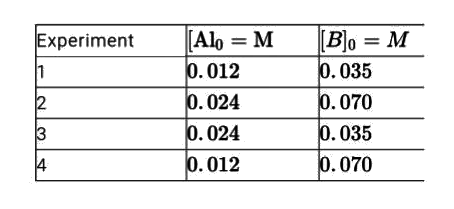For the reaction A→ B , the rate law expression is : Rate = k[A]. Which of the following statements is incorrect?
The reaction is said to follow first order kinetics
The half life of the reaction will depend on the initial concentration of the reactant
‘k’ is constant for the reaction at a constant temperature
The rate law provides a simple way of predicting the concentration of reactants and products at any time after the start of the reaction
The correct Answer is:B
To solve the question regarding the reaction A to B with the rate law expression Rate = k(A), we need to analyze the statements provided and determine which one is incorrect.
1. Identify the Rate Law Expression:
The rate law expression given is Rate = k(A). This indicates that the rate of the reaction depends linearly on the concentration of reactant A.
2. Determine the Order of the Reaction:
The order of a reaction can be determined from the rate law expression. Since the concentration of A is raised to the power of 1 (implied), the reaction is a first-order reaction.
3. Evaluate the Statements:
- Statement 1: "The reaction is said to follow first-order kinetics."
- This statement is correct because the rate law indicates a first-order reaction.
- Statement 2: "The half-life of the reaction will depend upon the initial concentration of the reactant."
- This statement is incorrect. For first-order reactions, the half-life is constant and does not depend on the initial concentration of A. The half-life (t₁/₂) is given by the formula t₁/₂ = 0.693/k, which shows that it only depends on the rate constant k.
- Statement 3: "A is constant for the reaction at a constant temperature."
- This statement is correct. The rate constant k is constant at a given temperature and does not change with the concentration of A.
- Statement 4: "The rate law provides a simple way of predicting the concentration of reactants and products at any time from the start of the reaction."
- This statement is correct. The rate law allows us to calculate concentrations at any time during the reaction.
4. Conclusion:
The incorrect statement among the options is Statement 2, which claims that the half-life of the reaction depends on the initial concentration of the reactant.
Final Answer:
The incorrect statement is: "The half-life of the reaction will depend upon the initial concentration of the reactant."
---
The rate law expression given is Rate = k(A). This indicates that the rate of the reaction depends linearly on the concentration of reactant A.
The order of a reaction can be determined from the rate law expression. Since the concentration of A is raised to the power of 1 (implied), the reaction is a first-order reaction.
- Statement 1: "The reaction is said to follow first-order kinetics."
- This statement is correct because the rate law indicates a first-order reaction.
- Statement 2: "The half-life of the reaction will depend upon the initial concentration of the reactant."
- This statement is incorrect. For first-order reactions, the half-life is constant and does not depend on the initial concentration of A. The half-life (t₁/₂) is given by the formula t₁/₂ = 0.693/k, which shows that it only depends on the rate constant k.
- Statement 3: "A is constant for the reaction at a constant temperature."
- This statement is correct. The rate constant k is constant at a given temperature and does not change with the concentration of A.
- Statement 4: "The rate law provides a simple way of predicting the concentration of reactants and products at any time from the start of the reaction."
- This statement is correct. The rate law allows us to calculate concentrations at any time during the reaction.
The incorrect statement among the options is Statement 2, which claims that the half-life of the reaction depends on the initial concentration of the reactant.
The incorrect statement is: "The half-life of the reaction will depend upon the initial concentration of the reactant."
Similar Questions
Knowledge Check
Rate of a general reaction A + B → products can be expressed as follows on the basis of collision theory.
Rate =ZABe−Ea/RT
Which of the following statements is not correct for the above expression?AZ is collision frequency andis equal to number of collisions per second per unit volume of the reaction mixtureBeEa/RT is the fraction of molecules with kinetic energy equal to or greater than EaCEa is activation energy of the reaction.DAll the molecules which collide with one other are effective collisions.
Find the rate law that corresponds to the data shown for the following reaction?

View SolutionFor a reaction A+B→ Products, the rate law is -Rate =k[A][B]3/2
Can the reaction be an elementray reaction ? Explain.
View SolutionThe rate of the reaction
3A+2B→ Products
is given by the rate expresison: Rate =k[A][B]2
If A is taken in excess, the order of the reaction would be
View SolutionForm the data given below for the reaction:A→B→ Products
the rate law expression is:
View SolutionFor a hypothetical reaction, A+B+C→ Products, the rate law is determined to be rate =k[A][B]2. If the concentration of B is doubled without changing the concentration of A and C, the reaction rate:
View SolutionFor a hypothetical reaction: A+B→ Products, the rate law is r=k[A][B]0. The order of reaction is
View SolutionFor the reaction 2A+B→2C+D which of the following does not express reaction rate?
View Solution
